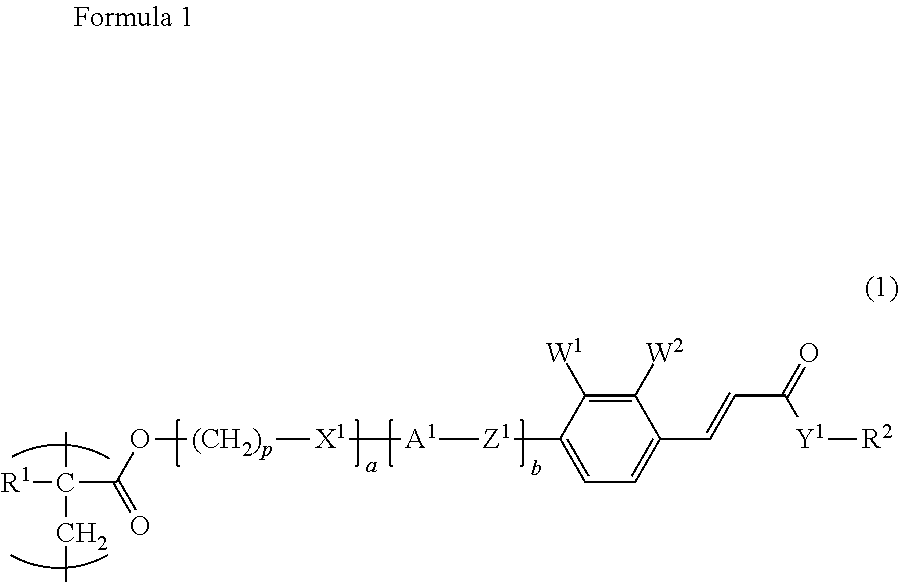Photosensitive polymer and photoalignable phase difference film
a phase difference film, photosensitive technology, applied in the direction of polarising elements, instruments, camera filters, etc., can solve the problems of limited stretching direction of stretched film, luminance inversion, and occasionally decreased luminance or contrast, so as to facilitate lamination of phase difference films, reduce manufacturing costs, and simplify manufacturing processes
- Summary
- Abstract
- Description
- Claims
- Application Information
AI Technical Summary
Benefits of technology
Problems solved by technology
Method used
Image
Examples
example 1
(i) Synthesis of Compound (M-1)
[0154]Compound (M-1) was synthesized according to a scheme described below.
[0155]Sss
[0156]
[0157]Hereinafter, synthesis of compound (M-1) will be more specifically explained.
[0158](First Stage: Synthesis of Compound (Ex-1))
[0159]To 250 mL of toluene, 50 g of p-acetoxybenzoic acid was added, and 0.2 g of pyridine was added thereto, and the resulting mixture was stirred while being heated at 60° C. Thereto, 39.6 g of thionyl chloride was added dropwise. After dropwise addition, the resulting mixture was stirred at 60° C. for 4 hours. A solvent was distilled off under reduced pressure, 250 mL of toluene was added again to the resulting residue, and the resulting mixture was stirred while being cooled under a nitrogen atmosphere. Thereto, a mixed solution prepared by adding 49.5 g of p-methyl coumarate and 42.1 g of triethylamine to 200 mL of acetone was added dropwise. After dropwise addition, the resulting mixture was stirred at room temperature for 8 hou...
example 2
Preparation of Phase Difference Film F-1
[0172]Polymer (P-1) was dissolved into cyclopentanone (CPN) to adjust a solution having a solids concentration of 15% by weight. The solution was filtrated with a filter having a pore diameter of 0.2 micrometers to prepare photoalignable phase difference agent (H-1). The photoalignable phase difference agent (H-1) was applied onto a glass substrate by spin coating. On the occasion, applicability was satisfactory. The substrate was heated at 80° C. for 2 minutes, and a solvent was removed to form a coating film. Photoalignment treatment was applied onto a surface of the coating film, using an ultra-high pressure mercury lamp (made by USHIO, INC.), by irradiating the surface with 150 mJ / cm2 of linearly polarized ultraviolet light having a wavelength near 313 nanometers from a direction at 90 degrees relative to a coated surface. The substrate was heated at 130° C. for 5 minutes to give phase difference film (F-1).
[0173]When phase difference film...
example 3
Preparation of Phase Difference Film F-2
[0174]Phase difference film (F-2) was obtained in a manner similar to the operations in Example 2 except that a solids concentration of photoalignable phase difference agent (H-1) was adjusted to be 20% by weight in a CPN solution.
[0175]When phase difference film (F-2) was interposed between two polarizing plates arranged in a crossed nicol, and rotated in a horizontal plane, the film turned into a bright and dark state, and was confirmed to be in homogeneous alignment.
PUM
| Property | Measurement | Unit |
|---|---|---|
| boiling point | aaaaa | aaaaa |
| temperature | aaaaa | aaaaa |
| wavelength | aaaaa | aaaaa |
Abstract
Description
Claims
Application Information
 Login to View More
Login to View More - R&D
- Intellectual Property
- Life Sciences
- Materials
- Tech Scout
- Unparalleled Data Quality
- Higher Quality Content
- 60% Fewer Hallucinations
Browse by: Latest US Patents, China's latest patents, Technical Efficacy Thesaurus, Application Domain, Technology Topic, Popular Technical Reports.
© 2025 PatSnap. All rights reserved.Legal|Privacy policy|Modern Slavery Act Transparency Statement|Sitemap|About US| Contact US: help@patsnap.com



